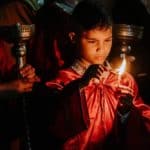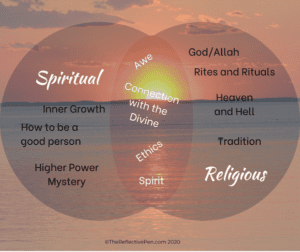SPIRITUAL, RELIGIOUS OR NEITHER?

 I often wonder what people mean when they say “I am spiritual, but not religious.” I think of myself in those terms. What does spirituality mean? What are the similarities and differences? Can a spiritual person be religious? Can a religious person be non-spiritual? (Photos by Malcolm-Lightbody and David-Clode on Unsplash)
I often wonder what people mean when they say “I am spiritual, but not religious.” I think of myself in those terms. What does spirituality mean? What are the similarities and differences? Can a spiritual person be religious? Can a religious person be non-spiritual? (Photos by Malcolm-Lightbody and David-Clode on Unsplash)
My seminary education failed to define these terms satisfactorily, which may have resulted from my difficulty understanding the language of theologians and philosophers. I find their writings are lengthy and obtuse treatises that lead to circular theories about the existence and nature of God.
Courses I took in homiletics, hermeneutics, and apologetics never moved me an inch closer to being a better person, with the possible exception of growing in humility. On my journey from religion to spirituality I replaced their dense texts with writers like Henri Nouwen and Thich Naht Hahn and poets like Mary Oliver and Rumi.
SPIRITUALITY VS RELIGION
 In general, spirituality answers the question “How do I stay connected? How do I live?” A spiritual person may look for meaningful connections with something bigger than themselves and often focuses on inner growth. They may or may not use any of the names for the Holy, like ‘God’ or ‘Allah’, but when I talk to a person who defines themself as ‘spiritual’ I know they are sensitive to something bigger than themselves. Perhaps “Higher Power.” I call it “Mystery”.
In general, spirituality answers the question “How do I stay connected? How do I live?” A spiritual person may look for meaningful connections with something bigger than themselves and often focuses on inner growth. They may or may not use any of the names for the Holy, like ‘God’ or ‘Allah’, but when I talk to a person who defines themself as ‘spiritual’ I know they are sensitive to something bigger than themselves. Perhaps “Higher Power.” I call it “Mystery”.
On the other hand, religion is based on tradition and uses sacred texts to define what is right and wrong. People seek connection with God/Allah/Elohim through rites and rituals.
Although spirituality and religion are not the same, I find myself dwelling in the overlap – a space that includes ethics, experiences of awe, personal practices of meditation, and service to others. For some, including myself, there is richness and comfort in this place where religions meets spirituality.
SOME SIMPLE PRACTICES IN THE OVERLAP
LECTIO DIVINA & VISIO DIVINA
 Lectio Divina means ‘holy reading.’ Originally a monastic practice dating back many centuries, it remains relevant to many people today.
Lectio Divina means ‘holy reading.’ Originally a monastic practice dating back many centuries, it remains relevant to many people today.
In a nutshell, it is a process of reading a short text several times and listening for a single word or idea to ‘chime’ in one’s heart. Then that word is used in meditation and contemplation, drawing a person deeper towards Mystery (God, Higher Power, the Universe).
‘Lectio’ originated in Eastern Orthodoxy using ancient Biblical texts in a five step process to connect with God. The same process can be practiced with any written words. – words from holy books of other religions, poetry, or prose to bring us into awareness of the Holy. Because the goal is not intellectual understanding, it is not a ‘study’ of any text. We discover words and phrases as portals into ‘Mystery.’(Photos by Rachid-Oucharia on Unsplash)
A variation of Lectio Divina is ‘Visio Devina’, a similar practice using images instead of words.
A SIMPLE CREATIVE PRACTICE FOR SPIRITUAL GROWTH
USING IMAGES AND QUOTES
Suppose exploring dense theological texts does to you what it does to me, but you want to grow spiritually. In that case, I encourage a practice of collecting quotes and/or images that resonate with you.
 If you are not a photographer, you can still access thousands of free photos on several sites. My favorite is Unsplash.com, but you can find others by searching for “free stock photos.”
If you are not a photographer, you can still access thousands of free photos on several sites. My favorite is Unsplash.com, but you can find others by searching for “free stock photos.”
There is no cost to use them, but it is nice to acknowledge their creators if you publish stock photos publicly such as on social media. (Caveat – although you can find images on Google, these are generally not licensed for public reuse.)
I keep a small notebook to write down quotes as I read. But another excellent source of quotes is Goodreads.com/quotes. There you type in a topic and voila! Profound comments by persons famous and not so well-known.
I often use quotes in a process adapted from Lectio Divina as described above, or as prompts for journaling. Quotes and images combined make inspirational collages. I encourage anyone who hasn’t tried it to play with a program called Canva.com and see what you come up with.
 When it comes to service as part of one’s spirituality, I suggest a practice of sharing positivity with others. It is effortless to create postcards on Canva to send to friends who need encouragement or to share on social media. We live in a time when the gift of inspiration and motivation is one that reaches through the barriers of social distancing. A card may be just what someone you know needs right now.
When it comes to service as part of one’s spirituality, I suggest a practice of sharing positivity with others. It is effortless to create postcards on Canva to send to friends who need encouragement or to share on social media. We live in a time when the gift of inspiration and motivation is one that reaches through the barriers of social distancing. A card may be just what someone you know needs right now.
I love to use quotes for creative inspiration. They can be seeds that bloom into drawing, painting, or writing for you. And they make great topics for group discussions – even by Zoom!
A FEW QUOTES FOR CONTEMPLATION
- “The fact that I can plant a seed and it becomes a flower, share a bit of knowledge, and it becomes another’s, smile at someone and receive a smile in return, are to me continual spiritual exercises.” (Leo Buscaglia)
- “There’s something overwhelming about being in raw nature. It’s got an aura about it that is really kind of majestic and spiritual.” (Christopher Lloyd)
- “We are not human beings having a spiritual experience. We are spiritual beings having a human experience.” (Pierre Teilhard de Chardin)
HOW TO USE QUOTES AND IMAGES AS A SPIRITUAL PRACTICE
When sitting with words of a poet, writer, or mystic as in the above quotes, my process includes many questions that I write in my journal. They might look like this –
- What are the seeds I carry? How much cultivation needs to happen for them to sprout?
- Where have I seen “raw” nature Christopher Lloyd talks about?
- Why does my experience of humanity overshadow my spiritual experiences so often?
Because I like to write, my answers may become an essay, a poem, or a prayer.
I have a friend who is an artist, and she thinks in color and shape. A response to the questions she asks may emerge as an abstract painting or a collage.
You may even discover a song or a rhythm within a quote arising from your questions. It’s time to pull out your guitar or drum and let them sing.
I share these ideas as models to help you in the process of exploring your spirituality through creative processes if you haven’t done so before. Some other articles you may enjoy are “What is Morning Practice” and “How to Find the Time for Spiritual Practice.”
If you already practice Lectio (or Visio) Divina, ‘Devotions,’ meditation, or another practice that sustains your spirit, please feel free to share in the comments below.


Pat Blethen
“My seminary education failed to define these terms satisfactorily, which may have resulted from my difficulty understanding the language of theologians and philosophers. I find their writings are lengthy and obtuse treatises that lead to circular theories about the existence and nature of God.”
I love this comment! I sometimes wonder in their intellectual efforts to define God, if they miss encountering God. I once asked a seminary professor why the seminary didn’t offer courses about spiritual practices, I was told something to the effect that it was assumed that one already knew these things before entering. So much for fostering spiritual growth!
Ardis Mayo
You nailed the biggest problem with a theological education, Pat.
helen Willey
So much to learn. Thanks for insights. Need all the help I can get. Helen
Ardis Mayo
And Thank you for reading, Helen. I’m glad you found this helpful